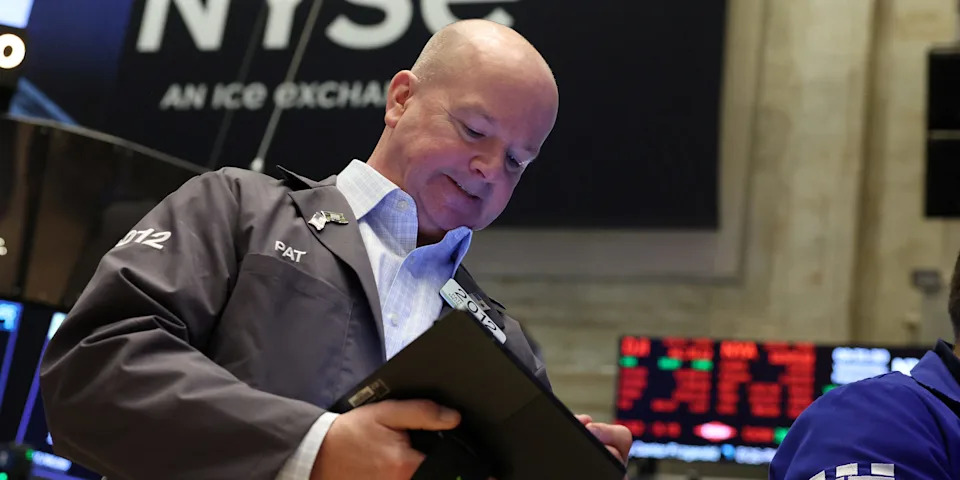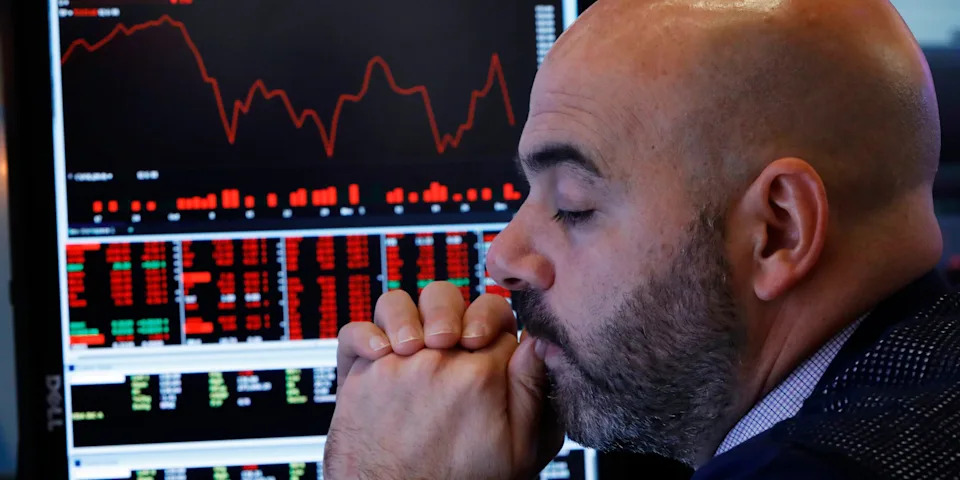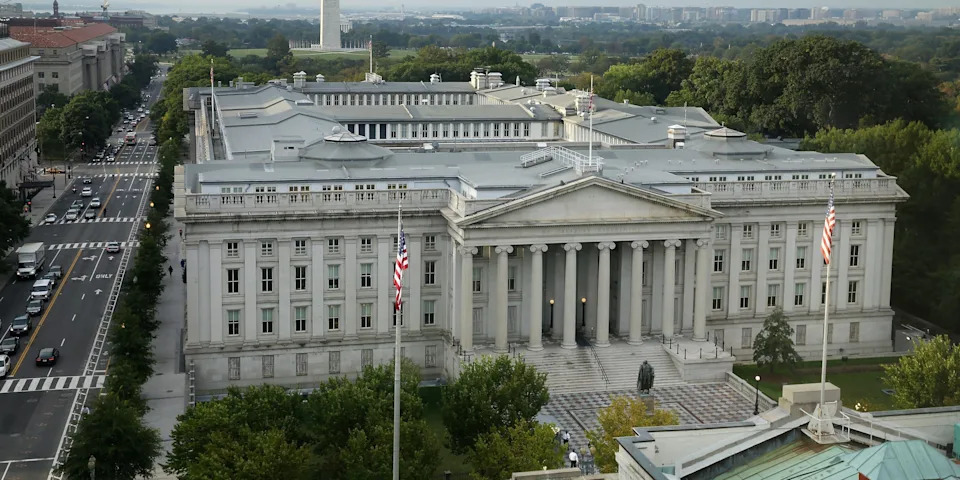The bond market went haywire this week. Here's why that's a warning for the US and Trump.

The bond market sent a warning to Donald Trump this week.
A sharp sell-off in Treasurys —unusual in times when recession fears are high and stocks are cratering—had a hand in pushing the president to pause the steepest reciprocal tariffs for 90 days.
Yields, which move in the opposite direction of prices, shot up as the trade war escalated this month, with the 10-year and 30-year US Treasury yields hovering around 4.5% and 4.9% on Friday respectively.
It's the highest yields have been since February, shortly after Trump took office and sparked a tantrum in the bond market after first laying out his tariff plans .
Why is this unusual?
While markets broadly have been volatile since Trump returned to the White House, such spikes in US government bond yields aren't normal.
It's a sign that investors may no longer be viewing government debt as a safe haven asset — something that could spell trouble for the stability of financial markets and future government funding, Wall Street experts say.
US Treasurys typically rally when equities sell-off and investors price in the risk of a recession. Treasurys, which are thought of as virtually risk-free, would usually rally in times like these, meaning yields would decline.
"This kind of thing just isn't supposed to happen for a market as large and liquid as US Treasuries," Ajay Rajadhyaksha, a managing director at Barclays, wrote in a note on Friday. " This is not normal. "
"US Treasuries traditional role as a risk-asset diversifier is coming into question this week," researchers at Société Générale said.
Why is this happening?
There are a few reasons markets pros say the sell-off in bonds accelerated.
Foreign selling
Foreign investors have been dumping their holdings of US Treasurys in recent months, possibly out of reduced faith in the US or to get access to US dollars in the event that trade with the United States starts to narrow.
Foreign investors sold Treasurys for the third month in a row in January, with net holdings dropping $13.3 billion, according to data analyzed by SocGen.
Foreign official investors also dumped $24.1 billion in Treasurys that month after significant selling in December, marking the largest two-month stretch of selling since the pandemic, the bank said.
China's holdings of US debt also decreased that month, and have been on the decline since 2013, analysts added.
"Trump raising pressure on all US trading partners may not bold well for their willingness to hold Treasuries," Société Générale added.
Bond market vigilantes throwing a tantrum
Tariffs are also hurting Treasury demand among US bond investors, who may have been making a statement about Trump's trade policy by selling to drive up yields.
It wouldn't be the first time bond investors have thrown a fit to make their point. Bond vigilantes , investors who shift away from bonds to pressure the government to exercise more fiscal restraint or pursue more favorable policies, staged a similar sell-off in bonds when Trump first took office, causing the 10-year yield to spike as high as 4.8%.
"The Bond Vigilantes have struck again," Ed Yardeni, the president of Yardeni Research, wrote in a note after Trump announced the 90-day tariff pause.
"Even though the Stock Vigilantes were clearly telling President Donald Trump that his tariff policy was misguided late last week, his advisers touted falling oil prices and bond yields as ultimately helping Main Street America."
The basis trade unwind
Hedge funds could also be in the process of unwinding a big leveraged bet on Treasurys known as the basis trade, which takes advantage of the difference between the bond price and the price of Treasury futures.
It is a source of market risk in times of volatility that's been flagged by big financial bodies including the Fed and the IMF in recent years.
"In case of an exogenous shock, the highly leveraged long positions in cash Treasury securities by hedge funds are at risk of being rapidly unwound," Torsten Sløk, Apollo's chief economist, wrote in a note on Tuesday.
What does it all mean?
The bond sell-off could hint at more bad news for financial markets. It's mainly a sign that investors' view of US Treasurys as ultra-safe assets is waning and that America's reputation as a premier destination for foreign investment has been damaged.
Investors could be starting to turn away from the US, Minneapolis Fed President Neel Kashkari suggested on Friday.
"Investors around the world have viewed America as the best place to invest, and if that's true, we will have a trade deficit," Kashkari said, speaking to CNBC. "If the trade deficit is going to go down, it could be that investors are saying, OK, America no longer is the most attractive place in the world to invest, and then you would expect to see bond yields go up."
Wall Street is concerned about what the sell-off could mean for future market volatility.

" We don't think risk assets can stabilize until the bond market does ," Barclays' Rajadhyaksha wrote. "Perhaps the events of this week were a one-off. And perhaps a deal is announced over the weekend that lifts sentiment, widens swap spreads, and causes longer US rates to rally and the USD to strengthen. But unless those things happen consistently for at least a few days — until US Treasuries go back to behaving the way they are supposed to — we would be very cautious on all risk assets."
"Bond investors should stay vigilant," Matt Egan, a portfolio manager at Loomis, Sayles & Company, said. "The recent price action suggests that the US Treasury market itself could become a source of instability—a risk that now feels more plausible than remote."
Finally, if investors are unwilling to buy as much government debt, that could lead to a funding problem for the US.
The government relies on investors purchasing debt securities to finance its activity — and there's around $3 trillion in US Treasury debt set to mature this year that will need to be refinanced.

That hasn't happened yet. Demand for the 10-year and 30-year US Treasurys was robust in auctions this week, with the government issuing $22 billion in 30-year bonds and $39 billion in 10-year bonds.
Yet, for a brief moment, the market was veering into dangerous territory, top economist Mohamed El-Erian said.
"We came very close today to the line that separates wild market movement in the bond market to market dysfunction," the chief economist advisor of Allianz, said on Wednesday, pointing to concerns about liquidity in markets. "We don't want to get there again. Because the more you get to that point repeatedly, the higher risk you're going to cross it."
Read the original article on Business Insider

